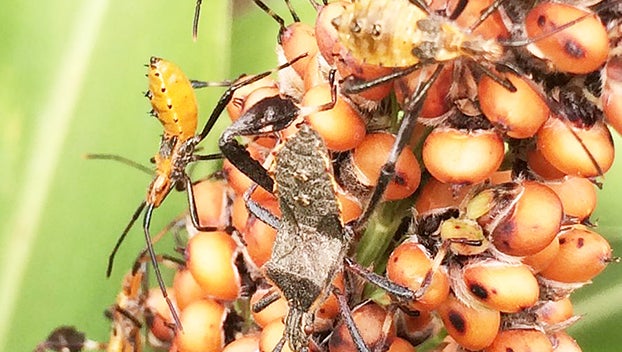CERTIFIED TEXAS EXPERT GARDENER — Detrimental garden pests include voracious appetites
Published 12:02 am Wednesday, April 3, 2024

- The leaf-footed bug in differing life cycles enjoys extracting nutrients from plants, piercing foliage, fruit, seeds and other plant parts, using modified mouth parts (tubes). (agrilife.org)
|
Getting your Trinity Audio player ready...
|
We decided to visit family members in North Alabama for Easter, which is a 10-hour drive from SETX, and always more exciting with our two dogs, who travel well … for the most part!
My enthusiasm for the trip naturally includes a few stops while on Sand Mountain, especially while in Guntersville. This gardener can’t refrain from checking out plant selection and varieties at roadside kiosks or “Mom & Pop” plant stands on the lake.
I need to know which plant varieties are available while this far north, and then determine if they will survive or adapt to our more rigorous, extreme SETX growing conditions. Plant tags scrutinized closely, as I’m searching for a mere possibility the plant could survive.
Gardeners, most of us have done this, purchased plants which will not perform well in our climate conditions (USDA zone) and “wished” them to succeed; disappointed when succumbed.
There are many instances where I have “fallen” into this gardening approach and purchased plants not recommended for our USDA zone. After selecting several beautiful plants, and then taking a few moments to reflect on past purchasing experiences, every plant selected was returned to the display areas. Even this old gardener isn’t too old to learn … occasionally.
This week’s discussion is a continuation from where we left off last week, beginning with ‘dreaded’ hornworms, which can decimate a tomato plant overnight.
Hornworms – are the nemesis of tomato plants and many other members of the nightshade family (peppers, eggplants, and potatoes). Plants can be beautiful, large well-shaped and full one day, and the next morning they might be bare, since hornworms typically feed at night.
There are a few ways to rid the garden of them. One option is to till the garden area before spring planting. Doing this will destroy the pupae living in the soil which will stop the five-spotted hawk or sphinx moth from hatching.
A second option (not for squeamish gardeners) is to pluck (hand-pick) them from plants and then destroy them. My preference is to interplant using Basil, Dill, Marigolds, Calendula, Borage, Basil, Chamomile or Nasturtiums. Each of these plants are odiferous, meaning they have strong aromas which confound the sphinx moth, while attracting beneficial wasps that attack the hornworm, laying their eggs on them.
Another option is to plant a ‘sacrificial’ crop, like flowering tobacco, which the sphinx moth finds irresistible. If you need an alternative to each of these options and feel the desire to “spray” something, use Bacillus thuringiensis (BT), which is a naturally occurring bacterium found in soils, which can help.
Leaf footed bug – some gardeners wrongly identify them as stink bugs. These are another type of insect “snacking” on tomatoes and peppers, leaving paled colored marks around the fruit. The best way to reduce their population starts with the nymph, before it gets into the adult stage.
An easy way to capture nymphs is by spreading a tarp, plastic sheet, newspaper or sheet on the soil surface, around each plant. Gently shake each plant to dislodge the nymphs, allowing them to fall onto the material below.
Carefully remove the plastic or sheet from below the plants, delivering the “critters” into a bucket of soapy water, where they will drown. Utilizes this process daily until they are gone. Another option is to spray the nymphs with a pre-made (ready to use) insecticidal soap.
Remember to spray the tops and bottoms of the leaves and include the stems. Repeat every three to four days until nymphs are no longer present. Do not use it if the outdoor temperature is above 90 degrees. Remove debris from the yard in winter to remove leaf footed insect eggs, which will most certainly be over-wintering.
Leaf Miners – using a naturally occurring microorganism (known as Spinosad), which can be purchased in a liquid form and sprayed on plant leaves to control this insect. Weekly treatment is necessary (every four-seven days) until the life cycle severed. A tested home remedy uses 2-cups vegetable oil and ½-cup liquid soap. Mix well and pour into a spray bottle, spray affected plants, repeating as needed until the miners have relocated, and up residence … in the neighbor’s garden.
Mealy bugs – are found almost everywhere, on most plants. Spraying works best, but be certain to spray plants completely, getting into crevices when spraying, to eradicate eggs the female might have laid in the “cooler” dark spaces.
Other approaches to rid of mealy bugs from plants is to dab with a cotton swab in isopropyl alcohol (rubbing alcohol), use a blast of water from a garden hose nozzle, or spray Neem oil (insecticidal soap). Two home remedies which are proven to work, first remedy is to mix ½-cup brewed black tea with 1 tsp. baking soda, 1 tsp. dishwashing soap, and adding 1 ½ cups of warm water into a hand-held sprayer, then spray infested plants thoroughly.
Repeat treatment as needed. A second option is to mix 2 tbsp of corn oil and dishwashing liquid (each) into a gallon of water, pour into a sprayer and apply thoroughly. Repeat as necessary.
Next week’s list includes nematodes, slugs, spider mites, and more.
Send Certified Texas Expert Gardener John Green your questions and please continue sending comments to jongreene57@gmail.com.





